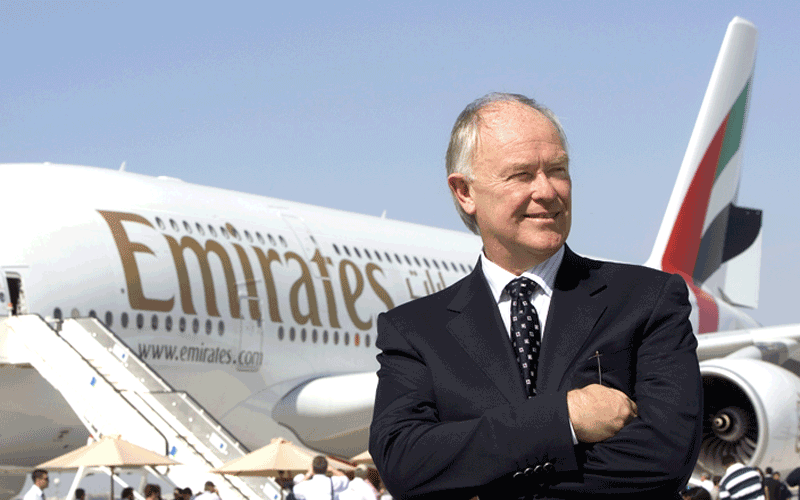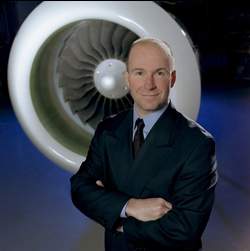Leeham News and Analysis
There's more to real news than a news release.
Emirates A350/787 bake-off remains wide open

Tim Clark, president of Emirates Airline. Photo: Skift.com via Google images.
June 9, 2015, c. Leeham Co. Competition between Airbus and Boeing remains wide open between the A350-900 and the 787-10, says the president of Emirates Airline despite an Internet report that the carrier has tilted toward Boeing.
“No, I don’t know where that’s coming from,” Clark today told Leeham News and Comment on the sidelines of the International Air Transport Assn. Annual General Meeting in Miami Beach. “If anything, the 10 is not coming up with the thrust requirements that we need. We’re working with Boeing on that, whereas the A350-900 has got bags of thrust.
Pontifications: Boeing finally cracks on 777 production rates, but spin continues
June 8, 2015, c. Leeham Co. Boeing finally said it may reduce production rates on the 777 Classic, but only initially by one aircraft per month and only starting in 2018.
Dominic Gates of The Seattle Times reported Saturday that Elizabeth Lund, VP for the 777 program, acknowledged the rate may have to come down but in a continuation of the message offered by CEO Jim McNerney during the first quarter earnings call in April, “feathering” the 777X production into the 777 Classic rate is the equivalent of maintaining the current rate of 8.3/mo, or 100 per year.
Boeing’s message has been evolving for some months. Originally Boeing said the production rate of the Classic will maintain the current rates right up to entry-into-service of the X, slated for 2020. Over the past several months, this definitive declaration has softened to the point of the current messaging.
As I wrote shortly after the 1Q earnings call, McNerney’s messaging wasn’t being swallowed by Wall Street analysts, or by this journalist.
Read more
A350 replacing A340-300 / 777-200ER, still on with lower fuel prices?
By Bjorn Fehrm
Subscription required.
Introduction
June 7, 2015, c. Leeham Co. We have just rounded off a series of articles around how A350 is to fly, its systems approach and lastly the conversion of Finnair’s A340/A330 pilots to A350. Finnair will replace the airlines A340-300 with the A350-900.
A question that comes up is how much more efficient is the A350 that is delivered to these airlines, and does the investment still make sense with today’s lower fuel prices? To get an answer we took the two customers that will get their A350 within the next months, Vietnam Airlines and Finnair, and we compared A350-900 to the aircraft that it will replace in their fleets, Boeing 777-200ER for Vietnam Air and Airbus A340-300 for Finnair.
We used our proprietary model to fly these aircraft over some typical routes for the airline’s, for Vietnam Airlines Saigon-London and for Finnair Helsinki-Shanghai.
Summary:
- The present aircraft are over 20% less efficient than A350 on these routes.
- For the A340 it is the engines which are the culprit, for the 777-200ER the wing.
- With a realistic fuel price for the planning period the differences in efficiency are large enough to motivate the switch.
IATA: Lufthansa welcomes US carriers to Mid-East dispute

Carsten Spohr, CEO of Lufthansa Group
June 7, 2015: The chief executive officer of Lutfhansa Airlines said he welcomes the Big Three US airliners to the dispute over whether the Big Three Middle Eastern carriers are unfairly competing against legacy airlines.
Carsten Spohr, CEO of Lufthansa Group, told a press conference on the opening day of the IATA Annual General Meeting that LH has long been complaining about Emirates Airline, Qatar Airways and Etihad Airways and their aggressive expansion, first in Europe and now the US.
American Airlines, Delta Air Lines and United Airlines are challenging open skies and subsidies to the ME3.
IATA AGM opens against mixed signals from industry
Miami Beach (FL), June 7, 2015: The International Air Transport Assn. (IATA) Annual General Meeting (AGM) opens against a backdrop of conflicting signals from the industry, including from the organization itself.
On the one hand, IATA said last week freight traffic declined in April after a robust start through the first three months of the year. Freight traffic is usually a harbinger of passenger traffic.
On the other hand, IATA said April passenger traffic was up higher than usual.
At the same time, Delta Air Lines warned its passenger revenue per available seat mile was falling on weaker short-term business bookings and Southwest Airlines continued a fare sale that, given typically strong load factors and going into the historically strong third quarter, indicates weaker traffic.
Bjorn’s corner: Conversion to A350, we talk to Finnair.
Introduction
June 4, 2015, c. Leeham Co. In our article series around A350 we now finish by covering how an airline prepares its pilots for flying A350. Here we were given the possibility to interview Finnair’s Flight Safety Manager Tapani Toppari on how Finnair will use Airbus training to convert their A330/340 pilots to include A350 in their type ratings.
Christian Norden, Airbus Director for A350 Flight Training, also furnished us with more information on how Airbus has improved their training philosophy for A350 training. This new training concept, called Evidence Based Training, has been developed by Airbus and other OEMs in cooperation with ICAO to counteract the tendency revealed by recent accidents that pilots had lost their manual flying skills and had deficiencies in their capability to solve unexpected problems.
A changing Airbus
By Bjorn Fehrm
Subscription required
Introduction
June 3, 2015, c. Leeham Co. Airbus, the commercial aircraft part of Airbus group, is in a change period which in terms of its results will be as profound as the many restructuring programs “Power 8”, “Power 8 plus” and “Future EADS” were in unifying and restructuring Airbus after the A380 problems.
The change is taking place in a very different environment. Airbus and Airbus group are no longer plagued by national infighting and severe duplication of resources, the drivers for the previous programs. Rather it is a necessary change for a company that goes from focusing on getting large new aircraft developments out the door and expand market share, to a company which needs to focus productivity and how to avoid complacency.
Widebody sales prospects this year
Subscription required.
Introduction
June 3, 2015, c. Leeham Co. Sales of widebody jets have slowed going into the Paris Air Show in under two weeks. Airbus sold six A330-200s, four A330-200Fs and

Boeing hopes to make a sale to Emirates Airlines later this year for the 787-10, giving a boost to this program and acing out Airbus in the process.
25 A330-900s, or 35 widebodies. No A350s. No A380s. Boeing sold three 747-8s, one 767, 25 777 Classics and (net) 34 787s, or 63 widebodies.
But we expect sales to pick up for the second half of the year, propelled by what appears to be enticing hints by Airbus that it may have finally achieved sales from China for its long-stalled A330ceo Regional airliner.
But the big prize, the Emirates Airlines order for 50-100 Airbus A350s or Boeing 787-10s (the number varies), is likely a late-in-the-year deal. There are a couple of others of decent size being competed as well.
And then there is the prospect of the launch of the Airbus A380neo.
Summary
- Airbus looks to Air Show to boost orders
- Boeing continues to hope 777F will save the day on the Classic
- Deals by year-end hoped for.
- Next big opportunity: the Dubai Air Show.
Airbus A350 cockpit compared to A320/A330.
By Bjorn Fehrm
Introduction
June 1, 2015, c. Leeham Co. In preparing for my A350 flight I learned how to interact with the aircraft’s systems in Airbus A320/A330 simulators. These two are very similar and represent the first generation of Fly By Wire (FBW) aircraft from Airbus. When flying the A350 I knew it had taken the cockpit philosophy from A380 rather than these two. I was therefore a bit curious as to how much my training would be applicable. On a first glance the differences between A320 and A380 cockpits are considerable.
To prepare for flying A350 we were sent a “A350-900 Flight Deck and Systems Briefing for Pilots”. When starting reading it the reaction was “there is a lot to learn, quite a bit of systems are different”. In the A350 simulator before the flight it turned out most changes were natural and easy to comprehend. To understand what has changed and if it is for the better or not, lets go through the changes and explain how it works in A350.





